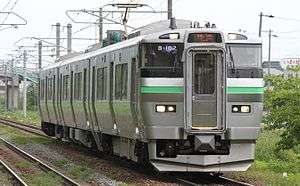733 series
| 733 series | |
|---|---|
|
Set B-102 on a Hakodate Main Line local service, June 2012 | |
| In service | 1 June 2012 – |
| Manufacturer | Kawasaki Heavy Industries |
| Built at | Kobe |
| Constructed | 2012– |
| Number built | 117 vehicles (32 sets) |
| Number in service | 105 vehicles (28 sets) |
| Formation | 3/6 cars per trainset |
| Fleet numbers | B-101–B-121, B-1001–B-1004, B-3101–B-3107 |
| Operator(s) | JR Hokkaido |
| Depot(s) | Sapporo |
| Line(s) served | Hakodate Main Line, Sasshō Line |
| Specifications | |
| Car body construction | Stainless steel |
| Car length |
21,200 mm (69 ft 7 in) (end cars) 20,800 mm (68 ft 3 in) (intermediate cars) |
| Width | 2,892 mm (9 ft 5.9 in) |
| Floor height | 1,050 mm (3 ft 5 in) |
| Doors | 3 per side |
| Maximum speed | 120 km/h (75 mph) (design speed 130 km/h (80 mph)) |
| Traction system | N-MT731A |
| Power output | 230 kW x 4 |
| Acceleration | 2.2 km/h/s |
| Electric system(s) | 20 kV AC overhead catenary |
| Current collection method | N-PS785 single-arm pantograph |
| Bogies | N-DT733 (motored), N-TR733 (trailer) |
| Safety system(s) | ATS-DN |
| Multiple working | 721 series, 731 series, 735 series |
| Track gauge | 1,067 mm (3 ft 6 in) |
The 733 series (733系) is an electric multiple unit (EMU) train type operated by Hokkaido Railway Company (JR Hokkaido) on suburban services in the Sapporo area of Hokkaido, Japan, since 1 June 2012.[1][2]
Variants
- 733-0 series: 3-car sets operated since June 2012
- 733-1000 series: 3-car sets to be operated on Hakodate Liner shinkansen access services from March 2016
- 733-3000 series: 6-car sets operated on Airport rapid services since July 2014
Design
Similar in appearance to the aluminium-bodied 735 series EMUs built in 2010, the 733 series EMUs have stainless steel bodies with steel driving cab ends.[3] At 2,892 mm, the 733 series cars are also wider than the 731 series and 735 series cars, which are 2,800 mm wide.[4] Sets B-113 onward, delivered from September 2013, feature full-colour LED destination indicators, instead of the three-colour indicators used on earlier sets.[5]
Five new six-car sets, classified "733-3000 series", were delivered in 2014 and phased in on Airport rapid services between Sapporo and New Chitose Airport from July, operating alongside the existing 721 series EMUs, and allowing the withdrawal of the remaining 711 series EMUs still in service.[6] These sets include a "u Seat" car with unidirectional reclining seating for reserved seat passengers.[6] The new sets feature LED lighting in the passenger areas.[6]
-
3-colour LED destination indicator showing bilingual display, August 2012
-
Full-colour LED destination indicator on set B-116, November 2013
Operations
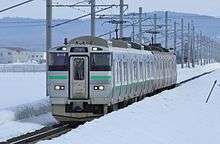
The 733 series sets entered service from 1 June 2012 on suburban services in the Sapporo area of Hokkaido, including the newly electrified Sasshō Line.[2] They are capable of running in multiple with 721 series, 731 series, and 735 series EMUs, but, unlike the 731 series, cannot operate in multiple with the KiHa 201 series DMUs also used on the Sasshō Line.[3][4]
Formations
As of 1 October 2015, the fleet consists of 21 three-car sets, numbered B-101 to B-121, and seven six-car 733-1000 series sets, numbered B-3101 to B-3107, formed as shown below, with one motored ("M") intermediate car and two non-powered trailer ("T") cars. Car 1 is at the Takikawa/Komakomai end.[5]
3-car sets (B-101 – B-121)
| Car No. | 1 | 2 | 3 |
|---|---|---|---|
| Designation | Tc1 | M | Tc2 |
| Numbering | KuHa 733-100 | MoHa 733-100 | KuHa 733-200 |
| Weight (t) | 33.9 | 43.1 | 35.5 |
| Capacity (total/seated) |
139/46 | 154/52 | 146/50 |
- Car 1 has a universal access toilet.[4]
- Car 2 is fitted with an N-PS785 single-arm pantograph.[5]
3-car 733-1000 series sets( B-1001 – B-1004)
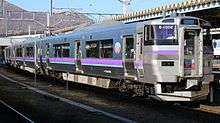
The fleet of four three-car 733-1000 series sets are formed as shown below, with car 1 at the Hakodate end.[7]
| Car No. | 1 | 2 | 3 |
|---|---|---|---|
| Designation | Tc1 | M | Tc2 |
| Numbering | KuHa 733-1000 | MoHa 733-1000 | KuHa 733-2000 |
| Weight (t) | 34.2 | 41.9 | 35.5 |
| Capacity (total/seated) |
138/46 | 156/52 | 145/50 |
-

KuHa 733-1002 of set B1002
-

MoHa 733-1002 of set B1002
-

KuHa 733-2002 of set B1002
6-car 733-3000 series sets (B-3101/3201 – B-3107/3207)
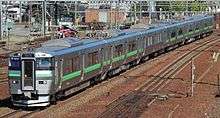
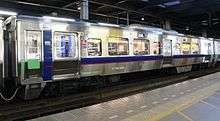
Seven six-car 733-3000 series sets are formed as shown below with two motored ("M") cars and four non-powered trailer ("T") cars. The sets each consist of two 3-car half sets, numbered "B-310x" and "B-320x", with car 1 at the Shin-Chitose end.[8]
| Car No. | 1 | 2 | 3 | 4 | 5 | 6 |
|---|---|---|---|---|---|---|
| Designation | Tc1 | M | T | Tu | M | Tc2 |
| Numbering | KuHa 733-3100 | MoHa 733-3100 | SaHa 733-3100 | SaHa 733-3200 | MoHa 733-3200 | KuHa 733-3200 |
| Weight (t) | 33.7 | 41.8 | 34.0 | 31.8 | 41.8 | 35.3 |
| Capacity (total/seated) |
142/46 | 156/52 | 149/48 | 72/43 | 156/52 | 146/47 |
- Car 4 has "u Seat" unidirectional reclining seating.[8]
- Car 1 has a toilet, and car 3 has a universal access toilet.[8]
- Cars 2 and car 5 are each fitted with an N-PS785 single-arm pantograph.[8]
Interior
The 3-car sets have longitudinal bench seating throughout, with a total capacity of 439 (148 seated).[4]
-

Interior view, showing priority seats highlighted in orange, September 2012
Bogies
-
N-DT733 motor bogie
-
N-TR733 trailer bogie
History
The first two 3-car sets, B-101 and B-102, were delivered from the Kawasaki Heavy Industries factory in Kobe in February 2012,[1][9] with two more sets, B-103 and B-104, delivered later the same month.[10][11] Twelve more sets (36 vehicles) are scheduled to be delivered during fiscal 2014.[12]
The first 733-3000 series six-car sets entered service on 19 July 2014.[13]
The first two 733-1000 series three-car sets, B-1001 and B-1002, were delivered from the Kawasaki Heavy Industries factory in Kobe in October 2015.[14]
Build details

The official delivery dates for the fleet are as shown below.[5]
| Set No. | Manufacturer | Date delivered |
|---|---|---|
| B-101 | Kawasaki Heavy Industries | 10 March 2012 |
| B-102 | Kawasaki Heavy Industries | 13 March 2012 |
| B-103 | Kawasaki Heavy Industries | 15 March 2012 |
| B-104 | Kawasaki Heavy Industries | 17 March 2012 |
| B-105 | Kawasaki Heavy Industries | 10 May 2012 |
| B-106 | Kawasaki Heavy Industries | 11 May 2012 |
| B-107 | Kawasaki Heavy Industries | 12 May 2012 |
| B-108 | Kawasaki Heavy Industries | 13 May 2012 |
| B-109 | Kawasaki Heavy Industries | 22 August 2012 |
| B-110 | Kawasaki Heavy Industries | 13 August 2012 |
| B-111 | Kawasaki Heavy Industries | 20 August 2012 |
| B-112 | Kawasaki Heavy Industries | 21 August 2012 |
| B-113 | Kawasaki Heavy Industries | 18 September 2013 |
| B-114 | Kawasaki Heavy Industries | 19 September 2013 |
| B-115 | Kawasaki Heavy Industries | 16 October 2013 |
| B-116 | Kawasaki Heavy Industries | 17 October 2013 |
| B-117 | Kawasaki Heavy Industries | 18 October 2013 |
| B-118 | Kawasaki Heavy Industries | 9 November 2013 |
| B-119 | Kawasaki Heavy Industries | 10 November 2013 |
| B-120 | Kawasaki Heavy Industries | 11 November 2014 |
| B-121 | Kawasaki Heavy Industries | 12 November 2014 |
| B-3101/3201 | Kawasaki Heavy Industries | 24 June 2014 |
| B-3102/3202 | Kawasaki Heavy Industries | 4 July 2014 |
| B-3103/3203 | Kawasaki Heavy Industries | 6 August 2014 |
| B-3104/3204 | Kawasaki Heavy Industries | 7 August 2014 |
| B-3105/3205 | Kawasaki Heavy Industries | 18 October 2014 |
| B-3106/3206 | Kawasaki Heavy Industries | 17 June 2015 |
| B-3107/3207 | Kawasaki Heavy Industries | 2 July 2015 |
Future plans
Four three-car 733-1000 series EMUs are scheduled to be introduced on shuttle services operating between Hakodate Station and the new Shin-Hakodate-Hokuto Station (a distance of approximately 18 km) when the Hokkaido Shinkansen opens in March 2016.[15] The new trains will have a modified livery, with purple and light green bodyside stripes.[15] The first sets are scheduled to be delivered in autumn 2015.[15]
References
- 1 2 臨時列車運転情報 [Non-scheduled train operation information]. Tetsudō Daiya Jōhō Magazine. Japan: Kōtsū Shimbun. 41 (334): 97/126. February 2012.
- 1 2 札沼線電化開業にともない733系が営業運転を開始 [733 series enter service following Sassho Line electrification]. Japan Railfan Magazine Online (in Japanese). Japan: Koyusha Co., Ltd. 2 June 2012. Retrieved 6 June 2012.
- 1 2 札沼線(学園都市線) 6月1日第一次電化開業 [First phase of Sasho Line electrification to open on 1 June]. Tetsudo Hobidas (in Japanese). Japan: Neko Publishing. 14 March 2012. Retrieved 14 March 2012.
- 1 2 3 4 JR北海道 733系通勤型交流電車 [JR Hokkaido 733 series AC commuter EMU]. Tetsudō Daiya Jōhō Magazine. Japan: Kōtsū Shimbun. 41 (337): 69. May 2012.
- 1 2 3 4 JR電車編成表 2016冬 [JR EMU Formations - Winter 2016] (in Japanese). Japan: Kotsu Shimbunsha. 18 November 2015. p. 6. ISBN 978-4-330-62315-3.
- 1 2 3 733系電車増備と快速「エアポート」への投入について [Details of additional order of 733 series trains and introduction on Airport rapid services] (pdf). News release (in Japanese). Japan: Hokkaido Railway Company. 14 May 2014. Retrieved 16 May 2014.
- 1 2 3 733系1000番台 [733-1000 series]. Japan Railfan Magazine (in Japanese). Vol. 56 no. 659. Japan: Koyusha Co., Ltd. March 2016. p. 72-74.
- 1 2 3 4 733系3000番台 [733-3000 series]. Japan Railfan Magazine (in Japanese). Japan: Koyusha Co., Ltd. 54 (642): 76–81. October 2014.
- ↑ 733系が甲種輸送される [733 series delivered]. Japan Railfan Magazine Online (in Japanese). Japan: Koyusha Co., Ltd. 9 February 2012. Retrieved 10 February 2012.
- ↑ 甲種鉄道車両輸送計画表 [Train delivery schedule]. Tetsudō Daiya Jōhō Magazine. Japan: Kōtsū Shimbun. 41 (335): 126. March 2012.
- ↑ 733系B-103編成とB-104編成が甲種輸送される [733 series sets B-103 and B-104 delivered]. Japan Railfan Magazine Online (in Japanese). Japan: Koyusha Co., Ltd. 28 February 2012. Retrieved 28 February 2012.
- ↑ Masahiro, Saka (May 2014). JR電車 3月15日ダイヤ改正と2013年度の動向 [JR EMUs: 15 March timetable revision and changes in 2013]. Tetsudō Daiya Jōhō Magazine (in Japanese). Japan: Kōtsū Shimbun. 43 (361): 22.
- ↑ 733系3000番台が営業運転を開始 [733-3000 series enter revenue service]. Japan Railfan Magazine Online (in Japanese). Japan: Koyusha Co., Ltd. 20 July 2014. Retrieved 21 July 2014.
- ↑ 〈はこだてライナー〉用733系1000番代甲種輸送 [Hakodate Liner 733-1000 series delivered]. RM News (in Japanese). Japan: Neko Publishing Co., Ltd. 6 October 2015. Retrieved 6 October 2015.
- 1 2 3 「函館~新函館北斗」アクセス列車用の車両について [New trains for Hakodate - Shin-Hakodate access services] (PDF). News release (in Japanese). Japan: Hokkaido Railway Company. 20 November 2014. Retrieved 20 November 2014.
| Wikimedia Commons has media related to 733 series. |
